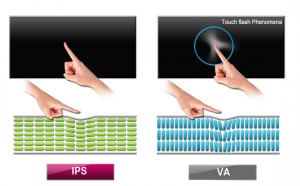IPS – The Clear Winner in the LCD Panel War

LCD TVs currently take up almost three quarters of the marketplace. But not all LCD panels are created equal.
There are important technological differences that don’t often get talked about when you go to the store. If you know about those, you’ll be able to make a better purchase and know precisely why you have to have a TV with an IPS-type panel.
When it comes to LCD TVs, there are really only two types to talk about, Vertical Alignment (VA) panels and In Plane Switching (IPS). As you can guess the main difference is how liquid crystals are aligned: Unlike VA types, IPS are horizontally laid out.
VA panels have some great strong points. For example, they can be very good at blocking light and creating deep blacks and contrasts. But what really sets the two types apart is the pixel structure.
VA panels use something called a non-homogenous electric field and two transistors per pixel. In comparison, IPS panels have a homogenous electric field and the ability to drive liquid crystals simply and efficiently. The result is a much faster response time with a very wide viewing angle that provides crisp and bright images without any color distortion.
What this also means is that IPS-based LCD TVs offer more vivid pictures without any motion blur because the signals can travel more quickly through the homogenous electric field.
 Another unique aspect of IPS is that when the surface is pressed or tapped, the picture remains stable, without flashing or leaving residual images. It’s something you can easily see for yourself at one of our LG brand shops.
Another unique aspect of IPS is that when the surface is pressed or tapped, the picture remains stable, without flashing or leaving residual images. It’s something you can easily see for yourself at one of our LG brand shops.
This characteristic is great if you have young kids who often feel the urge to get up close and personal with the TV screen. They can touch the screen all they like and there will be no light flash or residual deterioration of the screen.
It’s also an excellent choice if you use it in an office and make a lot of presentations because it lets you feel confident about touching the screen directly as opposed to having to keep your hand or pen hovering over it.
With VA screens, if you touch it, you’ll see water waves and eventual color degradation of the panel. IPS screens are comparatively much sturdier, which also makes them perfect for touch screens. And that’s one of the key reasons why Apple chose IPS for its iPhone.
On top of all that, the colors are also exceptionally consistent even when you view from a wide angle. Another factor that you can chalk up to the simplicity of the structure and that homogenous electric field is the fact that IPS is more energy efficient. VA panels, as mentioned above, use more than one transistor per pixel, which requires more power.
The superiority of IPS is also well recognized by many professional experts, such as graphic designers and surgeons, people for whom exactness and quality really do matter.
So when you go to buy your next TV, make sure you ask about the panel, and don’t be afraid to knock on it and see what happens. Is it an IPS or VA? The winner is clear.
About The Author
Related posts
No trackbacks yet.











No comments yet.